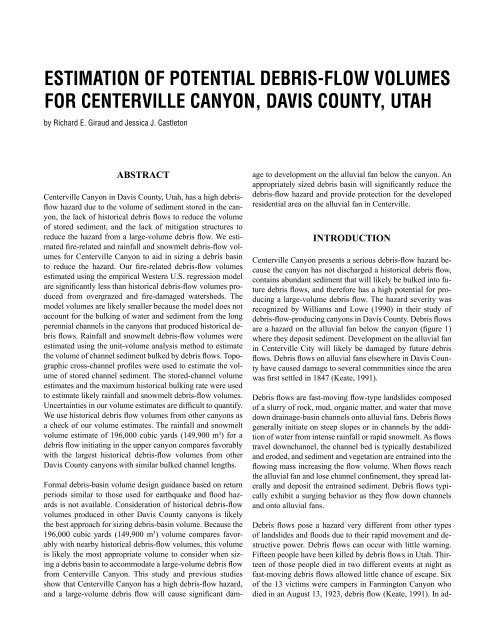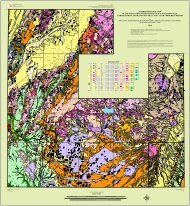Estimation of potential debris-flow volumes for Centerville Canyon ...
Estimation of potential debris-flow volumes for Centerville Canyon ...
Estimation of potential debris-flow volumes for Centerville Canyon ...
Create successful ePaper yourself
Turn your PDF publications into a flip-book with our unique Google optimized e-Paper software.
ESTIMATION OF POTENTIAL DEBRIS-FLOW VOLUMES<br />
FOR CENTERVILLE CANYON, DAVIS COUNTY, UTAH<br />
by Richard E. Giraud and Jessica J. Castleton<br />
ABSTRACT<br />
<strong>Centerville</strong> <strong>Canyon</strong> in Davis County, Utah, has a high <strong>debris</strong><strong>flow</strong><br />
hazard due to the volume <strong>of</strong> sediment stored in the canyon,<br />
the lack <strong>of</strong> historical <strong>debris</strong> <strong>flow</strong>s to reduce the volume<br />
<strong>of</strong> stored sediment, and the lack <strong>of</strong> mitigation structures to<br />
reduce the hazard from a large-volume <strong>debris</strong> <strong>flow</strong>. We estimated<br />
fire-related and rainfall and snowmelt <strong>debris</strong>-<strong>flow</strong> <strong>volumes</strong><br />
<strong>for</strong> <strong>Centerville</strong> <strong>Canyon</strong> to aid in sizing a <strong>debris</strong> basin<br />
to reduce the hazard. Our fire-related <strong>debris</strong>-<strong>flow</strong> <strong>volumes</strong><br />
estimated using the empirical Western U.S. regression model<br />
are significantly less than historical <strong>debris</strong>-<strong>flow</strong> <strong>volumes</strong> produced<br />
from overgrazed and fire-damaged watersheds. The<br />
model <strong>volumes</strong> are likely smaller because the model does not<br />
account <strong>for</strong> the bulking <strong>of</strong> water and sediment from the long<br />
perennial channels in the canyons that produced historical <strong>debris</strong><br />
<strong>flow</strong>s. Rainfall and snowmelt <strong>debris</strong>-<strong>flow</strong> <strong>volumes</strong> were<br />
estimated using the unit-volume analysis method to estimate<br />
the volume <strong>of</strong> channel sediment bulked by <strong>debris</strong> <strong>flow</strong>s. Topographic<br />
cross-channel pr<strong>of</strong>iles were used to estimate the volume<br />
<strong>of</strong> stored channel sediment. The stored-channel volume<br />
estimates and the maximum historical bulking rate were used<br />
to estimate likely rainfall and snowmelt <strong>debris</strong>-<strong>flow</strong> <strong>volumes</strong>.<br />
Uncertainties in our volume estimates are difficult to quantify.<br />
We use historical <strong>debris</strong> <strong>flow</strong> <strong>volumes</strong> from other canyons as<br />
a check <strong>of</strong> our volume estimates. The rainfall and snowmelt<br />
volume estimate <strong>of</strong> 196,000 cubic yards (149,900 m 3 ) <strong>for</strong> a<br />
<strong>debris</strong> <strong>flow</strong> initiating in the upper canyon compares favorably<br />
with the largest historical <strong>debris</strong>-<strong>flow</strong> <strong>volumes</strong> from other<br />
Davis County canyons with similar bulked channel lengths.<br />
Formal <strong>debris</strong>-basin volume design guidance based on return<br />
periods similar to those used <strong>for</strong> earthquake and flood hazards<br />
is not available. Consideration <strong>of</strong> historical <strong>debris</strong>-<strong>flow</strong><br />
<strong>volumes</strong> produced in other Davis County canyons is likely<br />
the best approach <strong>for</strong> sizing <strong>debris</strong>-basin volume. Because the<br />
196,000 cubic yards (149,900 m 3 ) volume compares favorably<br />
with nearby historical <strong>debris</strong>-<strong>flow</strong> <strong>volumes</strong>, this volume<br />
is likely the most appropriate volume to consider when sizing<br />
a <strong>debris</strong> basin to accommodate a large-volume <strong>debris</strong> <strong>flow</strong><br />
from <strong>Centerville</strong> <strong>Canyon</strong>. This study and previous studies<br />
show that <strong>Centerville</strong> <strong>Canyon</strong> has a high <strong>debris</strong>-<strong>flow</strong> hazard,<br />
and a large-volume <strong>debris</strong> <strong>flow</strong> will cause significant damage<br />
to development on the alluvial fan below the canyon. An<br />
appropriately sized <strong>debris</strong> basin will significantly reduce the<br />
<strong>debris</strong>-<strong>flow</strong> hazard and provide protection <strong>for</strong> the developed<br />
residential area on the alluvial fan in <strong>Centerville</strong>.<br />
INTRODUCTION<br />
<strong>Centerville</strong> <strong>Canyon</strong> presents a serious <strong>debris</strong>-<strong>flow</strong> hazard because<br />
the canyon has not discharged a historical <strong>debris</strong> <strong>flow</strong>,<br />
contains abundant sediment that will likely be bulked into future<br />
<strong>debris</strong> <strong>flow</strong>s, and there<strong>for</strong>e has a high <strong>potential</strong> <strong>for</strong> producing<br />
a large-volume <strong>debris</strong> <strong>flow</strong>. The hazard severity was<br />
recognized by Williams and Lowe (1990) in their study <strong>of</strong><br />
<strong>debris</strong>-<strong>flow</strong>-producing canyons in Davis County. Debris <strong>flow</strong>s<br />
are a hazard on the alluvial fan below the canyon (figure 1)<br />
where they deposit sediment. Development on the alluvial fan<br />
in <strong>Centerville</strong> City will likely be damaged by future <strong>debris</strong><br />
<strong>flow</strong>s. Debris <strong>flow</strong>s on alluvial fans elsewhere in Davis County<br />
have caused damage to several communities since the area<br />
was first settled in 1847 (Keate, 1991).<br />
Debris <strong>flow</strong>s are fast-moving <strong>flow</strong>-type landslides composed<br />
<strong>of</strong> a slurry <strong>of</strong> rock, mud, organic matter, and water that move<br />
down drainage-basin channels onto alluvial fans. Debris <strong>flow</strong>s<br />
generally initiate on steep slopes or in channels by the addition<br />
<strong>of</strong> water from intense rainfall or rapid snowmelt. As <strong>flow</strong>s<br />
travel downchannel, the channel bed is typically destabilized<br />
and eroded, and sediment and vegetation are entrained into the<br />
<strong>flow</strong>ing mass increasing the <strong>flow</strong> volume. When <strong>flow</strong>s reach<br />
the alluvial fan and lose channel confinement, they spread laterally<br />
and deposit the entrained sediment. Debris <strong>flow</strong>s typically<br />
exhibit a surging behavior as they <strong>flow</strong> down channels<br />
and onto alluvial fans.<br />
Debris <strong>flow</strong>s pose a hazard very different from other types<br />
<strong>of</strong> landslides and floods due to their rapid movement and destructive<br />
power. Debris <strong>flow</strong>s can occur with little warning.<br />
Fifteen people have been killed by <strong>debris</strong> <strong>flow</strong>s in Utah. Thirteen<br />
<strong>of</strong> those people died in two different events at night as<br />
fast-moving <strong>debris</strong> <strong>flow</strong>s allowed little chance <strong>of</strong> escape. Six<br />
<strong>of</strong> the 13 victims were campers in Farmington <strong>Canyon</strong> who<br />
died in an August 13, 1923, <strong>debris</strong> <strong>flow</strong> (Keate, 1991). In ad-

















